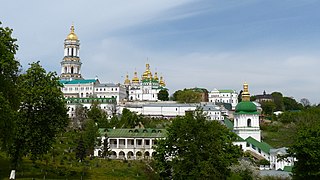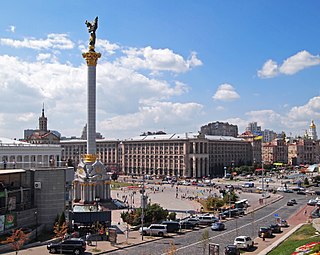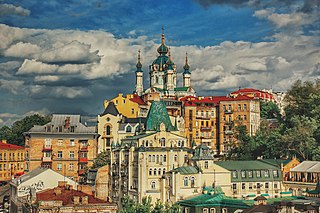
Vladimir Yevgrafovich Tatlin was a Russian and Soviet painter, architect and stage-designer. Tatlin achieved fame as the architect who designed The Monument to the Third International, more commonly known as Tatlin's Tower, which he began in 1919. With Kazimir Malevich he was one of the two most important figures in the Soviet avant-garde art movement of the 1920s, and he later became an important artist in the constructivist movement.

Kyiv-Pechersk Lavra or Kyievo-Pecherska Lavra, also known as the Kyiv Monastery of the Caves, is a historic Eastern Orthodox Christian monastery which gave its name to one of the city districts where it is located in Kyiv.

Kyiv is the capital and most populous city of Ukraine. It is in north-central Ukraine along the Dnieper River. As of 1 January 2022, its population was 2,952,301, making Kyiv the seventh-most populous city in Europe. Kyiv is an important industrial, scientific, educational, and cultural center in Eastern Europe. It is home to many high-tech industries, higher education institutions, and historical landmarks. The city has an extensive system of public transport and infrastructure, including the Kyiv Metro.

Maidan Nezalezhnosti is the central square of Kyiv, the capital city of Ukraine. One of the city's main squares, it is located on Khreshchatyk Street in the Shevchenko Raion. The square has been known under many different names, but often it is called by people simply Maidan ("square"). The square contains the iconic Independence Monument.

National University of Kyiv-Mohyla Academy is a highly ranked national research university located in a historic section of Kyiv, Ukraine. The university is bilingual in Ukrainian and English and is one of Ukraine's few universities with internationally recognized diplomas. NaUKMA takes part in numerous international university collaborations, such as the European University Association. With around 4000 students, NaUKMA is one of the smallest universities in Ukraine.

Andriivskyi Descent or Andrew's Descent is a historic descent connecting Kyiv's Upper Town neighborhood and the historically commercial Podil neighborhood. The street, often advertised by tour guides and operators as the "Montmartre of Kyiv", is a major tourist attraction of the city. It is included in the list of national landmarks by the government resolution. In addition, the street is also part of the Kyiv city historic reserve "Ancient Kyiv", while the St.Andrew's Church belongs to the National historic reserve "Sophia of Kyiv".

Square of Contracts or Contract Square is a square in the historic Podil neighborhood of Kyiv, the capital of Ukraine. The square is an important economic, cultural, and transport center of the Podil, containing numerous architectural and historical monuments.

Pyrohiv, originally a village south of Kyiv, now the National Museum of Folk Architecture and Folkways of Ukraine, is a 133.5 hectare open-air museum located at 1 Laureatska Street, Kyiv, Ukraine. An architectural and landscape complex representing the major historical and ethnographic regions of Ukraine, it is dedicated to the preservation and study of regional Ukrainian folkways.

Monument with Standing Beast is a sculpture by Jean Dubuffet in front of the Helmut Jahn designed James R. Thompson Center in the Loop community area of Chicago, Illinois. Its location is across the street from Chicago City Hall to the South and diagonal across the street from the Daley Center to the southeast. It is a 29-foot (8.8 m) white fiberglass work of art. The piece is a 10-ton or 20,000 pounds (9,100 kg) work. It was unveiled on November 28, 1984.
The Afghanistan 1979–1989 War Memorial is a monument in Kyiv (Kiev), the capital of Ukraine, commemorating soldiers who died fighting during the War in Afghanistan, after Soviet forces invaded that country in 1979. Unveiled in 1994, the memorial is located halfway between the Pechersk Lavra and the National Museum of the History of Ukraine in the Second World War.

The Seven Wonders of Ukraine are seven historical and cultural monuments of Ukraine, which were chosen in the Seven Wonders of Ukraine contest held in July, 2007. This was the first public contest of that kind which was followed by the Seven Natural Wonders of Ukraine, the Seven Wonderful Routes of Ukraine, and the Seven Wonderful Castles of Ukraine. All nominated sites are publicly owned protected areas of at least regional level, available for tourism.
Decommunization in Ukraine started during the dissolution of the Soviet Union in 1991 and expanded afterwards. Following the 2014 Revolution of Dignity and beginning of the Russo-Ukrainian War, the Ukrainian government approved laws that banned communist symbols, as well as symbols of Nazism as ideologies deemed to be totalitarian. Along with derussification in Ukraine, it is one of the two main components of decolonization in Ukraine.

The demolition of monuments to Vladimir Lenin in Ukraine started during the fall of the Soviet Union and continued to a small extent throughout the 1990s, mostly in some western Ukrainian towns, though by 2013 most Lenin statues in Ukraine remained standing. During Euromaidan in 2013–2014, the destruction of statues of Lenin become a widespread phenomenon and became popularly known in Ukraine as Leninopad, a pun literally translated as "Leninfall", with the coinage of "-пад" being akin to English words suffixed with "fall" as in "waterfall", "snowfall", etc.

Mystetskyi Arsenal National Art and Culture Museum Complex, also known as Mystetskyi Arsenal — is Ukraine's flagship public cultural institution, a museum and art exhibition complex located at 10–12 Lavrska Street, in Kyiv, Ukraine.
Derussification in Ukraine is a process of removing Russian influence from the post-Soviet country of Ukraine. This derussification started after the collapse of the Soviet Union in 1991 and intensified with the demolition of monuments to Lenin during Euromaidan in 2014 and the further systemic process of decommunization in Ukraine. The Russo-Ukrainian War gave a strong impetus to the process. Along with decommunization, derussification has been described as one of the components of a larger process of decolonization in Ukraine.












